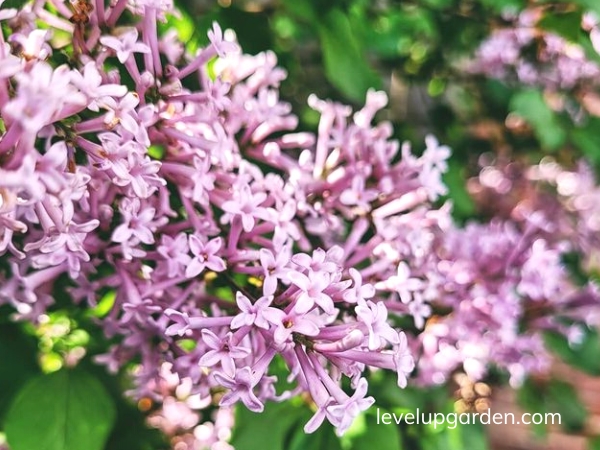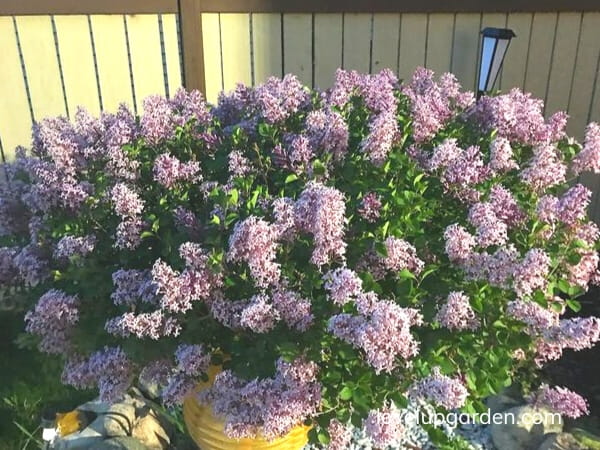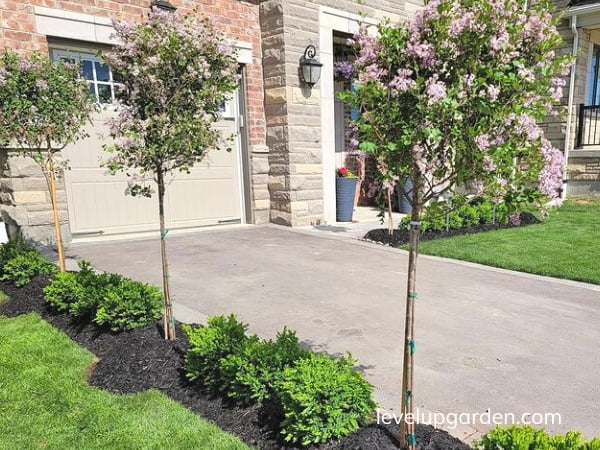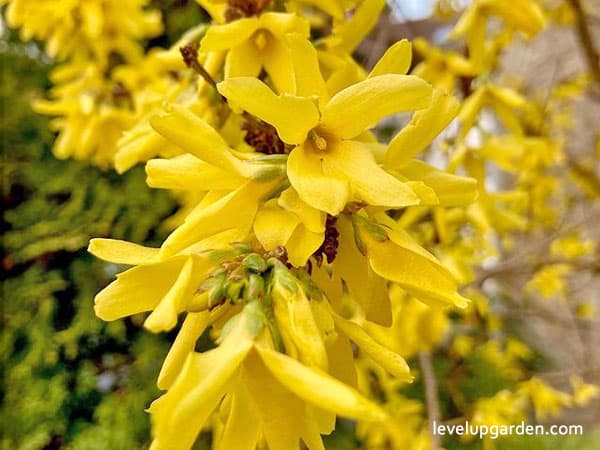The Korean Lilac (Syringa meyeri ‘Palibin’) is a medium-sized, deciduous shrub admired for its stunning light purple blooms and deep green, velvety leaves. Growing up to 5-10 feet tall and across, this compact plant flourishes in various environments, showcasing its delicate clusters of flowers in early to mid-May for around 14 days.

As a dwarf variety, the Korean Lilac is an ideal choice for small gardens or tight spaces, allowing for a burst of color and fragrance without overwhelming the area. Its soft lavender-pink flowers extend the lilac bloom season by about a week, making it an excellent option for borders, screens, and hedges.
With its rounded shape, resistance to powdery mildew, and low-maintenance nature, the Dwarf Korean Lilac stands out from other lilac varieties. This versatile shrub can be used as a deciduous hedge or foundation planting, ensuring it won’t obscure windows or take up valuable space in your garden.
Unlike most lilacs, Syringa meyeri ‘Palibin’ has the potential to bloom twice a year when spent flowers are trimmed back. Its first bloom occurs in mid-May, with the possibility of a second bloom from mid-summer until the first frost. With a maximum height of 4-6 feet and a spread of 5-7 feet, the Korean Lilac is an exquisite anchor plant for any flowering border or mixed landscape.
Korean Lilac Profile – An Overview of the Syringa meyeri ‘Palibin’
| Common name | Korean Lilac, Dwarf Korean lilac, dwarf Meyer lilac, ‘Palibin’ lilac |
| Botanical Name | Syringa meyeri ‘Palibin’ |
| Deciduous/evergreen | Deciduous |
| Fall Color | Red, Burgundy / Purple |
| Flower attributes | Large blooms, slightly fragrant |
| Flower color | Lavender purple |
| Foliage color | Dark green |
| Fragrant | Yes |
| Garden style | Cottage, Rustic |
| Growth Rate | Moderate |
| Hardiness zone | 4-8 |
| Mature Height | 6-10 ft. |
| Mature Width | 5-8 ft. |
| Moisture | Moderate |
| Plant Type | Shrub |
| Pruning Time | After Flowering |
| Soil | Widely Adaptable |
| Sunlight | Full Sun |
| Watering Needs | Moderate |
| Blooms | Spring |
| Origin | China, Japan |
Korean Lilac Appearance
Syringa meyeri, a compact shrub, reaches a maximum height of seven feet and spreads up to five feet. The plant showcases a captivating range of flower shades, from pinkish lavender to lilac and purple, making it a striking addition to any garden.

In spring, the foliage presents a deep burgundy shade, which transitions to dark green throughout the growing season. From early May to late June, the bushes are covered with blossoms, offering a vibrant and fragrant display.
As autumn arrives, the green leaves transform into a beautiful yellow hue before falling, unveiling attractive dark brown limbs and stems. The year-round interest and beauty of this lilac bush, also known as Miss Kim, make it a delightful choice for any landscape.
The Dwarf Korean lilac, a variety of Syringa meyeri, produces abundant clusters of tiny tubular pink flowers in mid- to late spring. The purple flower buds enhance the plant’s appeal even before it blooms. Known for their enchanting fragrance, these lilac bushes start blooming at a young age, filling the air with their captivating scent.
The foliage features small, glossy, dark green deciduous leaves, distinctly smaller and tidier than those of other lilac bushes. While other lilacs are susceptible to powdery mildew, the Dwarf Korean lilac is generally unaffected, making it an advantageous and low-maintenance option for gardeners.
Growing and Care Guide for Korean Lilac
The Dwarf Korean Lilac typically grows to a height of about 7 feet with a 4-foot spread at maturity. It has a slightly leggy appearance, with around 3 feet of clearance from the ground, making it suitable for planting under power lines. Growing at a slow rate, this plant can thrive for approximately 30 years under ideal conditions.

Full sunlight is essential for the healthy growth of this dwarf tree. It is highly adaptable to both dry and moist locations and can thrive under average home landscape conditions. The Dwarf Korean Lilac is not particular about soil type or pH and is highly tolerant of urban pollution, even flourishing in inner-city environments. Although it is a selected variety, this species is not originally native to North America.
The Dwarf Korean Lilac serves as an excellent addition to your yard and is equally well-suited for planting in outdoor pots and containers. Its upright growth pattern makes it an ideal centerpiece in container arrangements, where it can be surrounded by smaller plants and those with cascading growth habits. This lilac variety is even substantial enough to be the sole occupant of a suitably sized container. Keep in mind that when grown in containers, the plant’s performance might vary slightly from the provided description. Furthermore, plants in outdoor containers and baskets may necessitate more frequent watering compared to those rooted directly in the garden or yard.
Planting
To successfully plant a Korean Lilac Tree, begin by selecting an area with full sun and well-drained soil, ensuring that it receives 6 to 8 hours of sunlight daily. Once you have chosen an appropriate location, follow these steps:
- Dig a hole approximately twice the width and as deep as your tree’s root ball. This will provide ample room for the roots to spread and establish themselves.
- Gently remove your tree from its pot, taking care to untangle any encircling roots, which could strangle the plant and hinder its growth over time.
- Position the tree in the hole, ensuring that it stands upright and steady. Gradually fill the space around the tree with topsoil, firmly tamping it down as you go to eliminate air pockets.
- Water the area thoroughly to help settle the roots and establish a solid foundation for your tree.
- To retain moisture and prevent weed growth, apply a 2-3 inch layer of mulch around the base of the tree, extending outwards to cover the root zone.
Regarding the depth of Korean lilac roots, these shrubs require ample space to spread, as their roots can extend up to 1.5 times the width of the plant. Although not invasive, a 10-foot-wide lilac shrub may have roots stretching out approximately 15 feet in all directions.
Light
Although capable of tolerating some shade, the Dwarf Korean Lilac performs best with a minimum of 6 hours of sunlight daily.
Watering
During its initial growth phase, water your Dwarf Korean Lilac thoroughly at least once a week. After the tree is established, supplemental watering is only necessary during particularly dry or hot periods. To determine if watering is required, examine the soil 2 inches below the surface; if it feels dry, water the plant. Fertilize your lilac with a balanced, slow-release fertilizer intended for landscape plants once it starts blooming, typically in early spring.
Fertilizer
Use a well-balanced fertilizer, such as a 10-10-10 mix (representing the amounts of nitrogen, phosphorus, and potassium), once or twice a year after the tree starts blooming. We recommend applying the fertilizer annually in early spring, with a high-phosphorus formula to encourage blossoming.
Soil Requirements
The Korean Lilac Tree grows well in average, well-draining soil with dry to medium moisture. Full sun exposure is ideal for the best blooms. The tree prefers organically rich, moist, slightly acidic to slightly alkaline soils for optimal growth.
Spacing
Lilacs need ample space to grow. For a hedge, allocate a minimum of 7 to 8 feet in width, and 10 feet in width for a shrub. Ensure the lilac receives at least 6 hours of sunlight daily for optimal flowering, and plant it in well-draining, alkaline soil.
Growth Habit
The Dwarf Korean Lilac is a spreading woody perennial, popular among urban gardeners due to its ability to thrive in urban conditions.
Temperature
Hardy in USDA growing zones 4 to 8, the Dwarf Korean Lilac performs well in various conditions, requiring a sunny and well-draining spot in your yard. If drainage is poor, plant it on an 18-inch mound.
Pruning
After the Korean Lilac starts blooming, prune lightly for sizing and shaping. Remove faded blooms to encourage a stronger root system. The best time to prune is immediately after flowering, which promotes more blooms later in the year and maintains the bush’s rounded form. Remove dead, broken, or diseased branches as needed.
Pests and Diseases
Although hardy and rarely affected by pests or diseases, Korean Lilac may occasionally encounter leaf-mining moths and thrips. Control these pests with insecticides or predatory insects like green lacewings. Lilac blight, a bacterial disease causing twig and leaf blackening and wilting, can be managed by avoiding overhead watering, keeping plant bases clear of debris, and allowing sufficient space between plants.

Pollination
Lilac plants are monoecious, possessing both male and female reproductive parts on a single bush. Pollen from male flowers is transferred to female flowers by bees and other insects, leading to the production of small brown seeds upon successful pollination.
Maintenance
Dwarf Korean Lilac Trees can be grown outdoors in most of the continental U.S. and Canada, and even in containers. When planting in a container, select a pot twice the size of the root ball and use high-quality potting soil. Since they have a moderate growth rate, repotting into larger containers is necessary every 3-5 years. Container-grown plants may need extra watering and fertilizing, as they cannot access nutrients or water deep in the soil. However, the beauty of container-grown lilacs, such as a pair in decorative pots on either side of your entrance, makes the effort worthwhile.
Why is my Korean lilac not blooming?
The most common reason for a Korean Lilac not blooming is insufficient sunlight. Lilacs require at least six hours of strong, direct sun daily.
Why is my Korean lilac dying?
Inadequate sunlight might contribute to the problem. Ensure the lilac receives at least six hours of sunlight daily. Overwatering could also be an issue.
Do Korean lilacs bloom on old or new wood?
Lilacs bloom on old wood. Prune them soon after flowering to promote the formation of old wood (the current year’s growth) for the following year’s blooms.
How fast do Korean lilac grow?
Dwarf Korean Lilac reaches about 4 feet tall and 5 feet wide at maturity, growing at a slow rate. Under ideal conditions, it can live for approximately 30 years.
How often does a Korean lilac tree bloom?
This low-maintenance shrub blooms twice yearly. The initial bloom occurs in mid-May, followed by a second bloom from mid-summer to the first frost if spent flowers are trimmed back.
Varieties of Dwarf Korean Lilac
While the Korean Dwarf Lilac is a popular and well-known variety, there are several other dwarf lilac shrubs to consider for your garden. You can even mix and match these varieties for a diverse and visually appealing display.
Here are some attractive and popular dwarf lilac varieties:
Tinkerbelle: This highly fragrant lilac blooms earlier than other varieties, providing a continuous blooming period. It has deep lilac-purple flowers with a rich, spicy scent.
Miss Kim: This upright dwarf variety produces single blossoms in shades of pale blue to lavender, creating a striking display.
Josee: A reblooming lilac, Josee produces an abundance of pinkish-lavender blooms and typically blooms twice in a season.
Bloomerang: This extra small and compact lilac variety reaches a maximum height and width of four feet, making it perfect for smaller spaces.
Palibin: Known for its hardiness, the Palibin Korean lilac thrives even in USDA hardiness zone 3, making it a great choice for colder climates.
Uses
Design Ideas
The Dwarf Korean Lilac Tree is perfectly sized for small, compact hedgerows and makes excellent screening plants for a patio or deck. As an exceptional foundation plant, it pairs well with darker evergreens. Incorporate it into a mixed border for a more dramatic look in your yard. The spectacular dark green foliage and light spring blooms make it a great specimen plant.
Syringa meyeri ‘Palibin’ is suitable for any space. Use it as a single specimen or as a compact hedgerow in your landscape. To create a continuous screen and natural flowering hedge, plant the shrubs about 2 to 3 feet apart from the center.
The Dwarf Korean Lilac creates a modern look for your foundation plantings without growing too tall to block views. Edge these lilacs with small evergreens, or let them shine as a large container plant placed in a sunny spot. For a dramatic impact, consider mass planting the Syringa meyeri ‘Palibin’.
As an accent plant, the Dwarf Korean Lilac fits well in a mixed border. These shrubs naturally grow into a rounded shape and can add appeal when placed along the sides of your driveway. Alternatively, a single plant can serve as an enchanting focal point.
The fragrant lilac purple flowers appear at the ends of the branches in late spring, emerging from distinctive violet flower buds. These flowers are excellent for cutting. The dark green deciduous foliage starts as burgundy in spring, while the small pointy leaves do not develop any appreciable fall color.
Landscape Attributes
The Dwarf Korean Lilac is a dense deciduous dwarf tree, selected and trained to grow in a small tree-like form with the primary plant grafted high atop a standard. Its relatively fine texture sets it apart from other landscape plants with less refined foliage.
This low maintenance dwarf tree should only be pruned after flowering to avoid removing any of the current season’s flowers. It is a good choice for attracting butterflies to your yard and has no significant negative characteristics.

Ideal for use as a garden accent or patio feature, the Dwarf Korean Lilac is recommended for the following landscape applications:
- Accent
- General Garden Use
- Container Planting
Are Korean lilac trees toxic to dogs?
Lilacs do not contain any chemicals that will poison animals or humans, nor do they irritate the skin. Although lilac stems, leaves, and flowers pose no health threat to dogs, it is a good idea to keep your dog from chewing on the plant.
Why you should have a Korean Lilac tree
The Korean Lilac Tree is gaining popularity among garden enthusiasts and landscape designers alike, thanks to its eye-catching appearance and delightful fragrance. This dwarf tree is perfect for various settings, from patios to tight areas near homes, and offers vibrant neon purple blooms that will captivate anyone who sees it.
Not only is the Korean Lilac Tree strikingly colorful and fragrant, but it’s also low-maintenance and versatile. It thrives in full sunlight and can adapt to most soils, making it suitable for both garden and container planting. As a patio focal point, you can enjoy its dramatic display during the blooming season and appreciate its attractive shape and foliage afterwards.
The Korean Lilac Tree is resilient, growing well in various soil types, even poor quality or compacted ones, as long as they are not acidic. It’s resistant to drought, heat, and dry soil, and while deer tend to avoid it, the tree attracts hummingbirds and butterflies.
This easy-to-grow, deciduous shrub can be propagated from cuttings or seedlings and requires minimal maintenance. Dwarf varieties are more compact than their full-sized counterparts, maintaining a rounded shape with little or no pruning. The tree offers year-round interest with seasonal foliage color changes, enchanting fragrance, vibrant springtime blooms, and visually appealing limbs, twigs, and bark during winter.
Flowering in late spring, the Korean Lilac Tree fills the garden with its delightful scent. With resistance to common issues like powdery mildew and lilac borers, this versatile shrub is an excellent addition to any garden or landscape.
VI. FAQs
Does Korean lilac need full sun?
Dwarf Korean lilac thrives in both full sun and partial shade, and prefers average soil. Although it appreciates regular watering, it can tolerate drought once established. Apply a general fertilizer before new growth starts in spring, and remove spent flower heads to encourage better blooming the following year.
Is there a difference between a lilac tree and a lilac bush?
Lilacs, native to the Middle East, can be found as either trees or shrubs. Both forms captivate with their abundant clusters of fragrant flowers. Lilac trees are generally more delicate, while shrubs are smaller and more compact.
Are Korean lilacs fragrant?
The upright, compact Korean lilac blooms later than other varieties, prolonging the season with deep purple buds that open to reveal clusters of highly fragrant, lavender-blue flowers. The foliage takes on a burgundy hue in the fall.







